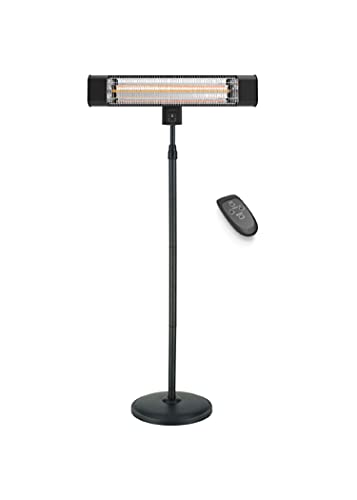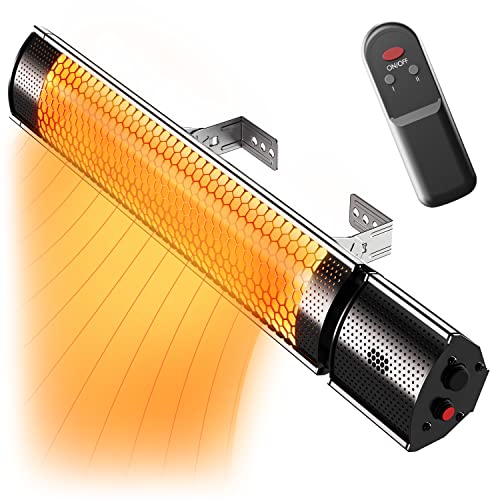The 10 Scariest Things About Heater Patio Gas

Waylon Rylah
2025-01-23 03:39
11
0
본문
 The Benefits of a Gas Patio Heater
The Benefits of a Gas Patio Heater A patio heater is a great method to enhance the ambience of an area. It is a great addition for restaurants, bars, and homes. It is important to maintain it in good working order.
A patio heater is a great method to enhance the ambience of an area. It is a great addition for restaurants, bars, and homes. It is important to maintain it in good working order.Gas patio heaters are powered by propane tanks that must be refilled when necessary. They are also less portable than electric models. Natural-gas patio heaters are connected to a natural gas line in the home and don't require refills, however, they are more costly to install.
Portable
Patio heaters are a great option to heat up outdoor areas in the colder months. They are suitable for commercial and residential use. It is easy to assemble and is able to be moved around to different locations. It gives you an immediate sensation of warmth with the power of a flame. This is especially the case for newer models that use radiant heating instead of direct convection. These heaters make use of liquefied petrol gas (LPG), propane, or natural gas to heat the space. The heat is then radiated by the reflective silver surface on top of the device. The heaters can produce between 5 and 12kW of heat.
In contrast to electric patio heaters which are wired to the wall and thus limited to the space they were placed in gas heaters is able to be moved easily to other areas of your backyard or deck. Most patio heaters have a separate gas tank that can be taken out and replaced as necessary. Certain models come with wheels, which make them more mobile.
Another advantage of a gas patio heater is that it can be used all year round even in colder weather. The burners used in these heaters are either propane or butane which has a lower boiling point than other fuels. Propane patio heaters can still work normally at -4 degC. Butane however, will struggle to vaporize.
Gas heaters are more powerful than electric patio heater vs gas heaters. It is more powerful since it doesn't rely on convection. Instead, a flame heats the metal structure beneath and emits heat to the surrounding area. It is able to heat the air more quickly and efficiently than heaters that rely on electricity, since it cannot transfer heat to objects in its range.
Easy to assemble
Gas patio heaters are a fantastic option to make use of your outdoor space in colder weather. These heaters generate a great deal of heat and are affordable to run. They also offer instant warmth, which is particularly beneficial when you're hosting an event. They are commonly used in outdoor seating areas of bars and restaurants. They can be either mounted or portable, based on your requirements. Certain models require a permanent hookup to your natural gas pipe, while others can be connected to propane tanks. Some models even have an option to turn on the heating at your choice.
If you're using a propane-powered heater for your patio, make sure to keep it away from anything that could catch fire. Keep a fire extinguisher close by and remind children to stay clear of roughhousing around it. It's also important to check for leaks periodically. You can do this by applying a soapy solution to the tank and hose connections. If you smell gas or see bubbles, you should switch off your heater right away.
Propane and natural gas patio heaters can be utilized in a wide range of outdoor spaces, although they must be properly ventilated to avoid carbon monoxide poisoning. They can be employed indoors in enclosed areas such as garages and patios but they should not be used outdoors in open spaces, such as basements. Gas heaters are not recommended for areas that are exposed to excessive rain or blowing debris.
There are a variety of types of patio heaters, including electric and LP-gas. Electric heaters don't emit any carbon monoxide or fumes, however, they have an lower maximum energy output than other fuel sources. If you're looking for an energy-efficient option, consider purchasing an LP-gas patio heater. These heaters have a continuous flame which generates more heat than electric heaters.
Certain LP-gas patio heaters have an automatic shutoff valve built-in which can ensure that there is no leakage when the flame is not lit. Some have a manual ignition system that allows you to light them with a long match or lighter. The best choice for your space will be determined by your budget and personal preferences.
Safer
Patio heaters have become increasingly popular among homeowners of cottages and homes who want to extend their outdoor living space into the winter months. However, there are several safety considerations that must be considered when using these heaters. Propane patio heaters should not be used indoors and should be kept at least 2 metres from material that is flammable. They should also be set on a stable surface to reduce the risk of falling over.
When you are looking for a patio heater that uses propane, ensure that it's equipped with a flame sensor. These devices monitor for an ignition source and stop the flow of propane if it's not detected. This stops fire hazards and carbon monoxide poisoning from occurring. Additionally, make sure your propane patio heater has a CSA rating and is maintained properly prior to use.
Other fuel sources for patio heaters include liquid propane, natural gas, and butane. Liquid propane is more volatile than butane and it is able to ignite through sparks. It is also less toxic than other gases, and has a lower melting point. This makes it safe for outdoor use. It is crucial to remember that propane liquid should be stored and transported in an area with good ventilation.
It is essential to check regularly for leaks in propane patio heaters. Before each use, ensure that the valves and connections are closed. Also the hoses and valves must be cleaned with soapy water to ensure they are free of deposits and bubbles. A gas valve or hose that leaks can be dangerous. Keep a fire extinguisher near to your propane heater, and be on the lookout for any indications of smoke.
It is also important to follow the manufacturer's guidelines when putting up your patio heater. Natural gas or propane patio heaters should be used outdoors and in areas that have good ventilation. They should not be used inside or in partially enclosed areas because they produce deadly levels of carbon monoxide. It's recommended to also install an alarm for carbon monoxide near outdoor heaters.
All all year round Use all year round.
Gas patio heaters bring instant and durable warmth to any outdoor space, whether you're hosting guests or relaxing on your own. They come in various sizes and styles that can be adapted to any design scheme. They can also serve as a focal point, providing visual interest to your garden or patio. Additionally, the flames of gas patio heaters have a natural aesthetic that can add a sense of ambiance to any evening.
There are a variety of patio heaters to choose from which include electric, gas and infrared. Each has advantages and disadvantages depending on the size and other aspects of the space that needs to be heated. It's crucial to know the differences between the different kinds to help you choose the best one for your needs.
Patio heaters are available in three types of fuel: propane, butane or natural gas. Propane gas is the most popular option due to its high efficiency and burns cleanly. However it is important to remember that it doesn't perform as effectively in colder temperatures. Butane can be a good alternative however it doesn't provide the same level of effectiveness as propane.
Patio heaters are available in a wide range of prices, depending on their style and model and also their installation costs. For instance, wall or ceiling-mounted natural gas gas patio heater gas patio heaters may be more expensive to install than free-standing models that are portable. They require an ongoing connection to your home's natural gas line and must be installed by an experienced professional.
Generally speaking, patio heaters use between 20 and 40,000 BTUs each hour to produce heat. The amount of heat generated can vary dependent on the size of the heater and its efficiency, as well as the weather conditions. The conditions of the wind and the position of the heater patio heater gas gas (Nerdgaming.science) can also affect how much fuel is consumed. To reduce the amount of fuel used look into a heater with adjustable settings.
Lastly, it's important to keep a fire extinguisher on hand when using a patio heater. This will avoid any accidents and emergencies. You can also purchase fire extinguishers designed for wood or gas patio heaters.

댓글목록0
댓글 포인트 안내